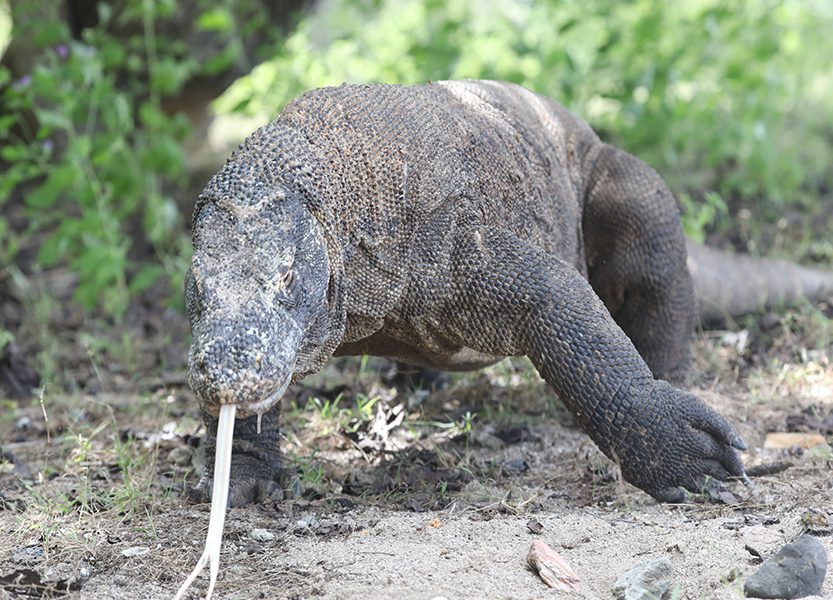Tales of the Dragon: Unveiling the Mysteries of Komodo
The air in South Kuta, Bali, often hums with the gentle rhythm of waves and the chatter of tourists. But just a short journey to the east, across a shimmering expanse of ocean, lies an ancient realm where the king of reptiles reigns supreme: Komodo Island. For centuries, whispered tales of a monstrous "land crocodile" have captivated the imagination, and today, I want to delve into the fascinating world of the Komodo dragon.
A Name as Ancient as its Lineage:
Known scientifically as Varanus komodoensis, this magnificent creature is more commonly referred to as the Komodo dragon. But what about its original name, the one whispered by the very people who share its rugged home? The locals, the indigenous people of these islands, often call it Ora. This simple, yet powerful, name speaks to a deep respect and perhaps a touch of fear for this formidable predator.
An Exclusive Domain: Why Only Komodo?
One of the most perplexing questions surrounding the Komodo dragon is its incredibly restricted habitat. Why are these colossal lizards found only on a handful of islands within the Komodo National Park – namely Komodo, Rinca, Gili Motang, and Nusa Kode, along with a small portion of western Flores?
The answer lies in a fascinating evolutionary journey and the power of geographical isolation. Fossil evidence suggests that the ancestors of Komodo dragons actually originated in Australia millions of years ago. They dispersed westward, reaching the Indonesian archipelago via ancient land bridges during periods of lower sea levels. As sea levels rose again, these populations became isolated on the islands we know today.
This isolation was crucial. Without larger, competing predators, the Komodo dragons thrived and, through a phenomenon called "island gigantism," evolved into the massive reptiles we see today. The unique ecosystem of these islands, with their rugged terrain and available prey, provided the perfect conditions for their dominance.
A Giant Among Lizards:
How big are they, you ask? These are not your average backyard lizards. Adult Komodo dragons can reach lengths of up to 3 meters (10 feet) and weigh over 70 kilograms (150 pounds), though some exceptionally large individuals have been recorded at over 160 kg. Their imposing size, muscular build, and powerful tails make them truly awe-inspiring.
What's on the Menu for a Dragon?
Komodo dragons are apex predators, meaning they sit at the top of their food chain. Their diet is incredibly varied and opportunistic. They hunt large animals such as deer, wild boar, water buffalo, and even other Komodo dragons. They are also known to scavenge on carrion, using their keen sense of smell to locate decaying carcasses from miles away.
Their hunting strategy is a patient, ambush approach. They lie in wait, camouflaged in the dry undergrowth, then launch a sudden, powerful attack.
Survival in a Harsh World:
Surviving on these arid, rugged islands demands incredible resilience. Komodo dragons have evolved remarkable adaptations:
- Exceptional Sense of Smell: Their long, forked tongues "taste" the air, picking up scent particles that help them locate prey and carrion.
- Powerful Bite and Venom: While once thought to rely solely on septic bacteria in their saliva, research has shown that Komodo dragons possess venom glands. This venom causes massive blood loss, lowers blood pressure, and induces shock, quickly incapacitating their prey.
- Strong Legs and Claws: They are surprisingly fast over short distances and can use their powerful claws to tear apart prey.
- Regurgitation: After a large meal, they can regurgitate a "gastric pellet" of undigested hair, teeth, and bone.
- Low Metabolism: They can go for long periods without food, conserving energy in a lean environment.
Dangerous Encounters? Always with a Ranger.
Yes, Komodo dragons are dangerous. They are wild, powerful predators and should be treated with extreme caution and respect. While attacks on humans are rare, they can be fatal. This is precisely why every single visitor to Komodo National Park is required to be accompanied by an experienced ranger.
These rangers are not just guides; they are highly trained professionals who live and work in close proximity to these magnificent reptiles. They understand dragon behavior, their preferred habitats, and the subtle cues that indicate a dragon's mood or intent. They carry long, forked sticks, not for striking the dragons, but for maintaining a safe distance and, if absolutely necessary, deflecting a curious or aggressive approach. They lead you on designated paths, ensuring you don't inadvertently stumble upon a resting dragon or interrupt a hunt. Their presence is paramount to a safe and respectful encounter with these powerful creatures.
A Living Relic:
To stand on Komodo Island and witness an Ora in its natural habitat is to step back in time. These magnificent creatures are living relics, a testament to millions of years of evolution and adaptation. Their continued existence is a delicate balance, reliant on conservation efforts to protect their dwindling populations and the unique islands they call home. As the sun sets over the rugged hills of Komodo, casting long shadows across the landscape, one can't help but feel a profound sense of wonder and a renewed commitment to safeguarding these truly legendary dragons.



